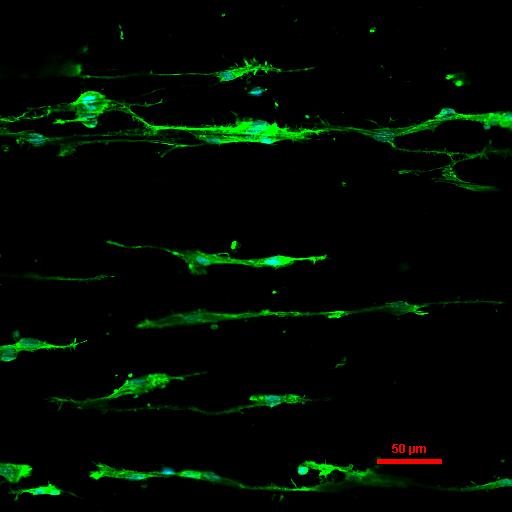Migration and differentiation of neural stem cells in novel random and aligned nanofibrous scaffolds.
-
1
Istituto Italiano di Tecnologia (IIT), Smart Materials, Nanophysics,, Italy
-
2
University of Genoa, DIBRIS, Italy
-
3
Istituto Italiano di Tecnologia (IIT), Neuroscience and Brain Technologies Department, Italy
-
4
Loughborough University, Department of Materials, United Kingdom
Introduction: In tissue engineering, stem cell therapies have been proposed to boost the repair of injured tissues. In particular, several studies on the regeneration of the central nervous system have demonstrated the importance of combining neural stem cells (NSCs) and polymer scaffolds. In fact, expandable sources of neurons and properly engineered scaffolds, which can provide neural differentiation to specific lineage, can be instrumental for the effective repair of the neural tissue [1]. Among the different structures of scaffolds, nanofibers are highly attractive for their ability to mimic the extracellular matrix in regenerative medicine [2].
Materials and Methods: In this study, polymer scaffolds, constituted by randomly distributed or aligned nanofibers, were fabricated by electrospinning. The realized fibrous scaffolds were characterized in terms of morphology by Scanning Electron Microscope (SEM), mechanical properties, and biocompatibility. The attachment, migration and differentiation of neural stem cells were also investigated in random and aligned nanofibers.
Results and Discussion: The results of SEM show that the fibers are free from beads and defects and very well aligned in the case of a specific type of scaffold. The Young’s modulus and tensile strength of aligned fibers significantly increase compared to random fibers. The scaffolds are able to promote the proliferation and differentiation of NSCs without laminin functionalization. The NSCs, seeded on the 3D scaffolds, not only attached and proliferated, but also were able to migrate and infiltrate inside the porosity of the fibrous mats. In this way, 3D cellular networks were created. Furthermore, the alignment of the fibers induced the growth of NSCs along one specific direction. In fact, the cells were able to highly elongate following the direction of fibers, creating aligned parallel patterns (Figure 1).

Figure 1. Morphology of neural stem cells in the aligned fibers
Conclusion: The obtained results demonstrate that the developed scaffolds are characterized by exceptional biocompatibility and that the topographical cues can be advantageously used in neural tissue engineering.
References:
[1] L. Binan, C. Tendey, G.D. Crescenzo, R.E. Ayoubi, A. Ajji, M. Jolicoeur, Biomaterials 2014, 35, 664-674.
[2] H. Hajiali, J. A. Heredia-Guerrero, I. Liakos, A. Athanassiou, E. Mele, Biomacromolecules 2015, 16 , 936–943.
Keywords:
Cell Differentiation,
Tissue Engineering,
nanofiber,
Scaffold
Conference:
10th World Biomaterials Congress, Montréal, Canada, 17 May - 22 May, 2016.
Presentation Type:
Poster
Topic:
Biomaterials in nerve regeneration
Citation:
Hajiali
H,
Contestabile
A,
Athanassiou
A and
Mele
E
(2016). Migration and differentiation of neural stem cells in novel random and aligned nanofibrous scaffolds..
Front. Bioeng. Biotechnol.
Conference Abstract:
10th World Biomaterials Congress.
doi: 10.3389/conf.FBIOE.2016.01.01413
Copyright:
The abstracts in this collection have not been subject to any Frontiers peer review or checks, and are not endorsed by Frontiers.
They are made available through the Frontiers publishing platform as a service to conference organizers and presenters.
The copyright in the individual abstracts is owned by the author of each abstract or his/her employer unless otherwise stated.
Each abstract, as well as the collection of abstracts, are published under a Creative Commons CC-BY 4.0 (attribution) licence (https://creativecommons.org/licenses/by/4.0/) and may thus be reproduced, translated, adapted and be the subject of derivative works provided the authors and Frontiers are attributed.
For Frontiers’ terms and conditions please see https://www.frontiersin.org/legal/terms-and-conditions.
Received:
27 Mar 2016;
Published Online:
30 Mar 2016.